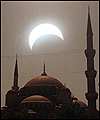|
Motion and Phases of the
Moon
- Orbit: The Moon revolves the
Earth with a prograde orbit, with period (sidereal month) 27.3
days [it covers 12°/day, almost 1 km/sec], tilted 5°;
It is not exactly a circle [the distance can be measured to within
a few meters with radio waves], so the Earth-Moon distance varies
by about 13% over one orbit [it also increases by about 4 cm/year!].
- Rotation: The Moon shows always the
same side to us because it completes exactly one rotation per revolution;
We will see that there is a reason.
- Phases of the Moon: The main
ones are new, quarter (waxing, waning), full Moon; The Sun always
illuminates half of the Moon, so why do we see different phases?
- Relationship with time of the day:
Because the phase of the Moon depends on its position along its
orbit, the times of day at which can we see the Moon in each
phase varies. What is the relationship?
- Sidereal vs lunar (synodic) month:
The cycle of phases repeats every 29.5 days; Why not 27.3 days,
which is the orbital period?
|
_230x230.jpg)
|




_250x180.gif)

![]()